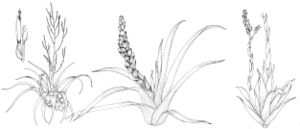Guzmania
Flora Peruviana 3: 37. 1802.
| Taxon | Illustrator ⠉ | |
|---|---|---|
 | Tillandsia utriculata Guzmania monostachia var. monostachia Catopsis berteroniana | Yevonn Wilson-Ramsey Yevonn Wilson-Ramsey Yevonn Wilson-Ramsey |
Herbs, usually epiphytic, stemless to rarely caulescent. Leaves many-ranked, usually ligulate, margins entire. Inflorescences 5–many-flowered, many-ranked, mostly 2-pinnate to less commonly single spike, flowers laxly to densely arranged; floral bracts broad, conspicuous, mostly obscuring rachis. Flowers bisexual; sepals distinct to connate over 1/2 length, usually symmetric; petals with claws adherent to subconnate petal, forming short tube, blade distinct; stamens usually included, adherent to adnate with petal claws; ovary superior. Capsules cylindric, dehiscent. Seeds with basal, usually tan-brown plumose appendage.
Distribution
Widespread in the moist Neotropics
Discussion
Species ca. 160 (1 in the flora).
Selected References
Lower Taxa
"distinct" is not a number.